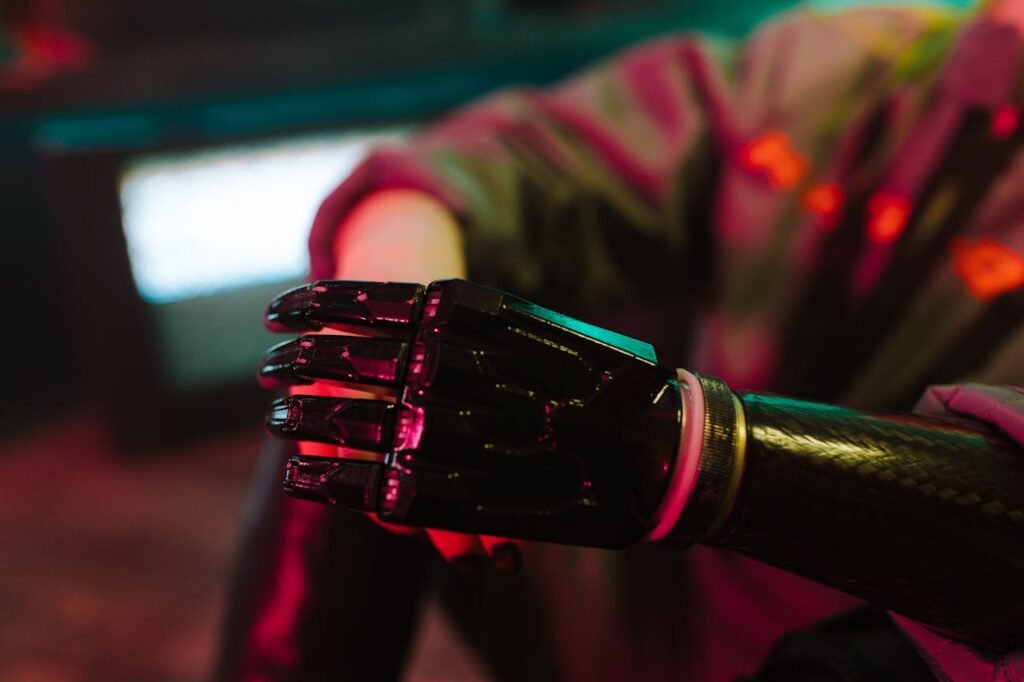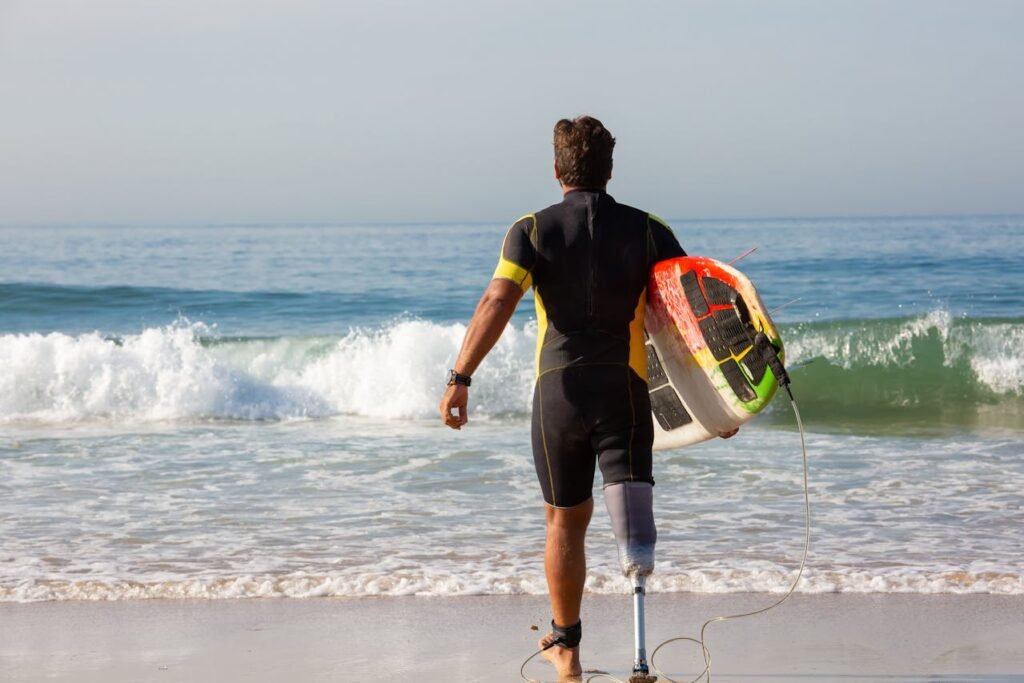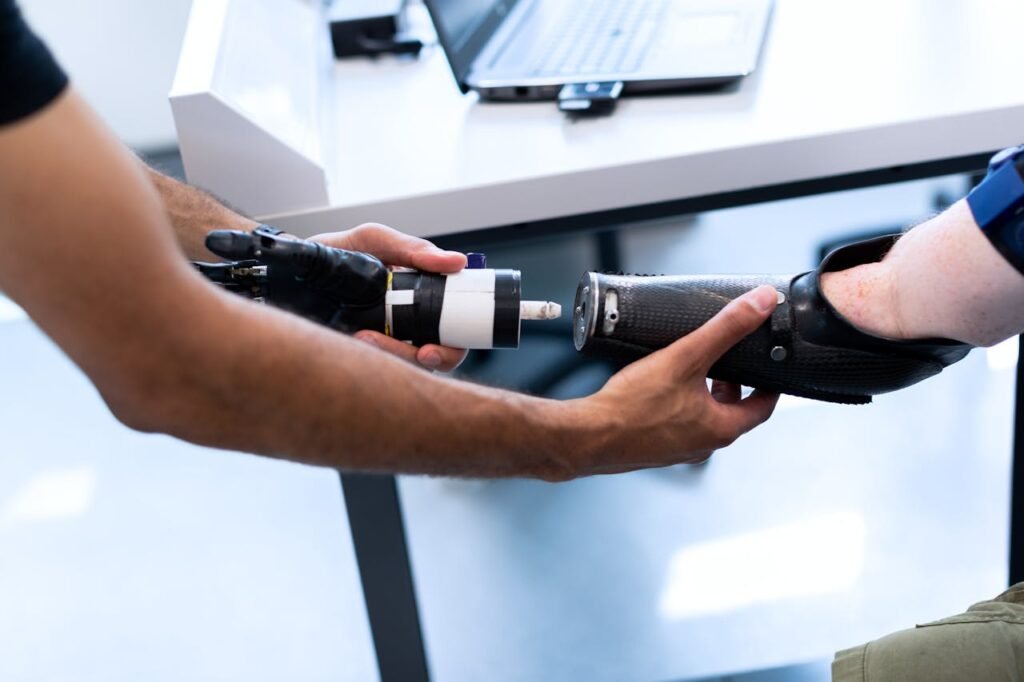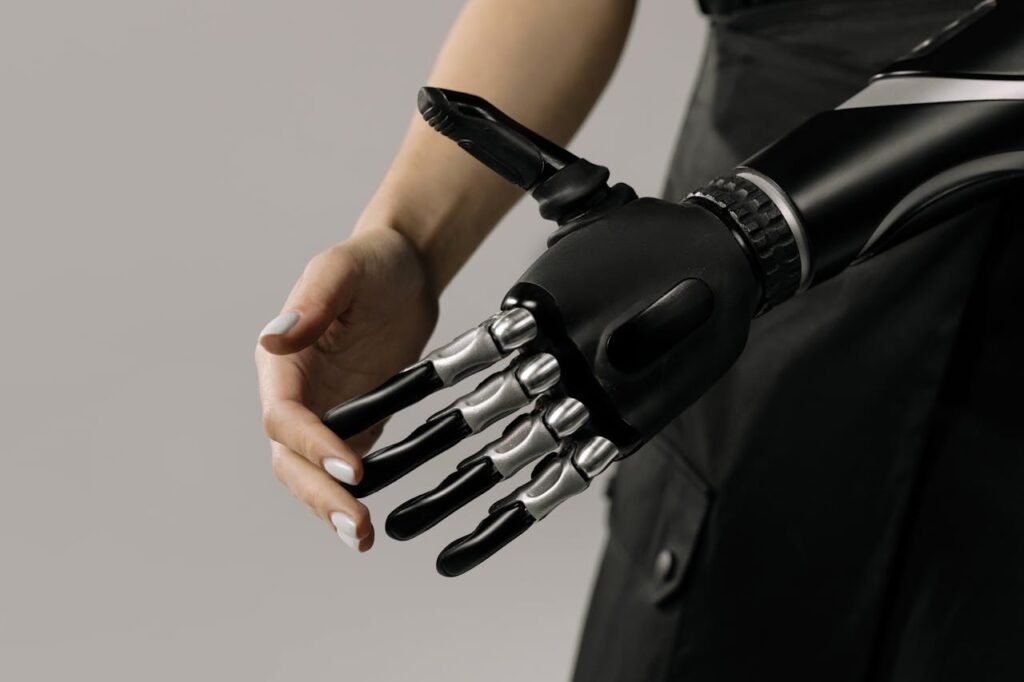When someone first receives a bionic limb, they often think it’s all about the device. They look at the hand, the joints, the sensors, and imagine that the technology will do everything. But the truth is different. The real driver of bionic control is not the machine—it’s the brain.
For patients, this idea is not always clear. They may believe that once the prosthetic is fitted, it will simply respond. What they don’t realize is that their brain needs to learn, adapt, and build new connections for the device to work naturally.
Helping patients understand this is one of the most important parts of prosthetic training. When they know why their brain matters, they practice with more focus, more patience, and more belief. And when clinics explain it clearly, patients become partners in their own recovery.
This article explores how to guide patients through this understanding. It explains the brain’s role in bionic control, why neuroplasticity is the key to success, and how physiotherapists and prosthetists can teach this in simple, human ways. It also offers practical steps to make brain-based training a natural part of every rehab journey.
Let’s begin.
The Brain’s Role in Bionic Movement
The Brain as the Command Center

Every movement in the body starts in the brain. When you reach for a glass of water or tie your shoes, the brain sends electrical signals down nerves to muscles. These signals tell the muscles when to contract and how much force to use.
With a natural limb, this process feels automatic. You don’t stop to think about each step. The brain and body work together in a seamless loop.
When a limb is lost, part of this loop is broken. The brain still sends signals, but they don’t reach the missing muscles in the same way. For bionic control to work, the brain must relearn how to send signals that the prosthetic can read and respond to.
How Myoelectric Signals Work
Modern bionic hands, like our Grippy™, use sensors to detect tiny electrical signals from the residual muscles. These signals are created when the brain tells those muscles to contract.
The sensors pick up the signal, the device interprets it, and the hand moves. If the brain sends a clear, strong message, the prosthetic responds smoothly. If the message is weak or inconsistent, the movement will feel clumsy.
This is why patients need to understand that control doesn’t begin in the device. It begins in their own mind and body. The prosthetic is only as good as the signals it receives.
Why the Brain Must Adapt
After amputation, the brain’s map of the body changes. It still “thinks” the limb is there, which is why many people feel phantom sensations. To use a prosthetic well, the brain has to build a new map that includes the device.
This process doesn’t happen overnight. It takes practice, repetition, and guidance. Each time the patient contracts a muscle and sees the prosthetic respond, a new connection is formed. Over time, these connections grow stronger, until the action feels more natural.
Helping patients see this clearly makes them more patient with themselves. They stop expecting instant results and start focusing on building these new pathways one step at a time.
Helping Patients Understand Neuroplasticity
What Neuroplasticity Means
Neuroplasticity is a simple but powerful idea: the brain can change. It can form new connections, strengthen weak ones, and reorganize itself after injury or loss.
For amputees, neuroplasticity is the reason bionic control is possible. Even though part of the body is gone, the brain can rewire itself to make sense of the prosthetic.
When patients hear the word, it may sound scientific. That’s why it’s important to explain it in simple terms. You can tell them, “Your brain is like a muscle—it gets stronger the more you train it.” This makes the concept clear and motivating.
Why Explaining Neuroplasticity Builds Commitment
Patients who don’t understand the brain’s role may get discouraged quickly. If they can’t use their prosthetic easily in the first week, they may think it’s not working or that they are failing.
By teaching them about neuroplasticity, you shift the focus. Instead of expecting instant mastery, they begin to see training as practice. They realize that each repetition is building new brain pathways, even if progress feels slow.
This change in perspective keeps them engaged. They understand that effort today pays off tomorrow, and that persistence is the key to success.
Making Neuroplasticity Visible
One way to teach patients about brain rewiring is to use feedback tools. Many prosthetics include visual displays or apps that show signal strength. When patients contract their muscles and see a bar rise on the screen, it makes the invisible process visible.
You can also use simple analogies. Compare the brain to learning to ride a bicycle or play an instrument. At first, every movement feels awkward. With practice, it becomes smooth and automatic.
These explanations help patients trust the process. They begin to see the prosthetic not as a strange tool, but as something their brain is actively learning to control.
Early Communication Strategies to Teach Patients About Their Brain’s Role
Using Everyday Language

When explaining the brain’s role in bionic control, the biggest mistake is using overly technical terms. Words like “cortical remapping” or “neuromuscular adaptation” may confuse or intimidate patients.
Instead, keep it simple. Use comparisons to everyday experiences. For example:
- “Your brain is like a coach, and your muscles are the players. If the coach gives clear instructions, the players perform well.”
- “Learning to use this hand is like learning to type. At first you have to think about every key, but eventually your brain remembers and it feels automatic.”
These kinds of explanations make complex science easy to understand and relatable.
Setting Realistic Expectations From Day One
Patients often arrive with two extremes of expectation: either they believe the prosthetic will do all the work, or they fear it will be too complicated to control. Both mindsets can lead to disappointment.
The first sessions are the best time to explain the truth: the prosthetic is a tool, and the brain is the driver. Tell patients that learning takes time, just like learning to walk after sitting for a long period. Repetition is what makes the brain adapt.
When expectations are clear, patients are less likely to quit when progress feels slow. They stay committed because they know what to expect.
Demonstrating Progress in Small Steps
Talking about brain adaptation is helpful, but showing it is even better. Start with simple exercises where patients can see immediate results—like contracting a muscle and watching the prosthetic hand open or close.
Even if the movement is small, celebrate it. Say, “That was your brain telling the hand what to do. Each time you do that, the connection gets stronger.”
By highlighting these small wins, you make the role of the brain visible. Patients begin to feel ownership over their progress.
Encouraging Reflection During Sessions
A powerful way to reinforce the brain’s role is to ask patients what they feel during training. For example:
- “Did you notice how your shoulder moved when you tried that?”
- “What did it feel like when the hand responded correctly?”
These questions prompt patients to think about the link between their thoughts, muscles, and the prosthetic. Reflection strengthens awareness, which strengthens learning.
Building Trust Through Transparency
Patients often wonder why some days feel easier than others. One day their signals are strong; the next day they feel weak or inconsistent. Without explanation, this can feel like failure.
This is where transparency matters. Tell them that the brain and body naturally fluctuate. Stress, fatigue, or posture can all affect signal quality. Reassure them that inconsistency is part of the process, not a setback.
By normalizing these ups and downs, you prevent discouragement and build trust. Patients realize they are not broken—their brain is simply adjusting.
Practical Training Techniques That Highlight the Brain’s Role
Mirror Therapy as a Brain Primer
Before patients begin with a prosthetic, mirror therapy can help prepare the brain. By placing a mirror next to the intact limb, the brain “sees” two working limbs. This illusion encourages neuroplasticity and reduces phantom pain.
When explained to patients, mirror therapy becomes more than a trick. It becomes proof that the brain is adaptable. They see with their own eyes how vision and thought can shape perception. This makes them more open to the idea that their brain will also adapt to controlling a prosthetic.
Signal Feedback Tools
Many prosthetics, including advanced models like Grippy™, provide feedback systems. These can display signal strength or offer tactile cues. Using these tools in training makes the brain’s role visible.
For instance, when a patient contracts a muscle and sees a bar on a screen rise, they understand: “That was my brain sending a signal.” This reinforces the connection and makes practice more engaging.
Repetition With Purpose
Physiotherapists often emphasize repetition, but patients may see it as boring. Explaining why repetition matters changes the perspective. Tell patients, “Each time you repeat this, your brain is building a stronger pathway. It’s like laying bricks to build a road. The more bricks you lay, the smoother the road becomes.”
This simple analogy turns repetition into a meaningful activity. Patients begin to see each movement as progress, not as routine.
Gradually Reducing Visual Dependence
In the early stages, patients watch their prosthetic closely. This is natural, but long-term control depends on the brain relying on sensation, not just vision.
A useful exercise is asking patients to look away during simple movements. At first, they may feel uncertain. But when they succeed, they realize that their brain can guide the prosthetic without constant checking. This strengthens trust in the brain’s role.
Overcoming Patient Doubts About the Brain’s Role in Bionic Training
“Why Isn’t This Working Yet?”

One of the most common frustrations patients express is the feeling that the prosthetic should respond immediately. When it doesn’t, they may think the device is faulty or that they are not capable of learning.
This is where education is critical. Remind patients that their brain is like a student in a classroom. It is learning a new language—the language of signals. Just as it takes time to learn words and grammar, it takes time to learn control.
Reassure them that slow progress does not mean failure. It means the brain is in training. Every session, no matter how small the improvement, is part of the learning process.
“My Brain Feels Tired”
Patients often don’t realize that controlling a prosthetic is mentally demanding in the beginning. They may say they feel drained or mentally fatigued after practice.
Normalize this experience. Tell them, “Your brain is working hard because it’s forming new pathways. Just like your muscles feel sore after a workout, your brain feels tired after learning.”
Encourage short, frequent sessions instead of long ones. This prevents frustration and helps the brain consolidate learning without exhaustion.
“Some Days Are Worse Than Others”
Signal inconsistency is another source of doubt. Patients may have strong control one day and weak control the next. They may feel discouraged, thinking they’ve lost progress.
Explain that this is normal. Stress, sleep, emotions, and even hydration can affect brain signals. Fluctuation does not mean regression. It simply means the brain and body are adjusting to real-life conditions.
One way to manage this doubt is to track small improvements over time. If a patient held an object for two seconds last week and now can hold it for four, that progress is worth celebrating—even if daily control feels uneven.
“Will My Brain Ever Feel Natural With This?”
Many patients worry that the prosthetic will always feel foreign. They wonder if it will ever truly feel like part of them.
This is where the concept of embodiment comes in. With enough repetition, the brain can begin to treat the prosthetic as part of the body’s map. Share examples of patients who reached this stage—where movements became automatic and natural.
Encourage them by saying, “It won’t happen overnight, but your brain is capable of including this hand in its body map. Each repetition brings you closer.”
Using Success Stories to Build Belief
Stories are powerful. When patients see or hear about others who have successfully integrated their prosthetic, they gain hope.
Share examples of people who struggled in the beginning but eventually mastered their device. If possible, connect new patients with peer mentors who can share their journey. Hearing directly from someone who has “been there” makes the brain’s role in adaptation feel more believable.
Creating Patient-Centered Training Plans
Personalizing the Approach
Every brain is different. Some patients may learn quickly, while others need more time. Some may struggle with strength, while others face emotional barriers. A one-size-fits-all plan rarely works.
Physiotherapists and prosthetists should design training plans that reflect each patient’s strengths, challenges, and goals. This personalization not only makes progress more likely but also makes patients feel understood and supported.
Setting Achievable Milestones
Big goals like “master the prosthetic” can feel overwhelming. Break them down into small, achievable steps. For example:
- Week one: consistent signal generation
- Week two: opening and closing the hand without looking
- Week three: holding a light object steadily
Each milestone should be celebrated as a win. This builds momentum and reinforces the idea that the brain is learning and adapting steadily.
Combining Physical and Mental Training
Patients often think training is only about muscle exercises. But mental training is just as important. Techniques like imagined movement, where patients picture themselves moving the prosthetic, activate the same brain regions as real movement.
By combining physical and mental exercises, clinics create a more complete training plan. This helps the brain adapt faster and keeps patients engaged even when physical practice isn’t possible.
Encouraging Daily Integration
Finally, training should not stay in the clinic. Patients should be encouraged to integrate practice into daily life. Even small actions—like holding a toothbrush, lifting a cup, or tapping on a phone screen—help the brain build lasting connections.
Explain to patients that every real-life action is practice. The more they use the prosthetic in meaningful ways, the faster the brain adapts.
Advanced Techniques to Reinforce the Brain’s Role in Bionic Control
Practicing Under Distraction

In real life, people don’t use their hands in silence and focus—they use them while talking, walking, or multitasking. Patients need to learn that their brain can still send accurate signals even when attention is divided.
Physiotherapists can simulate this by adding distractions to training. Play background sounds, ask the patient to hold a conversation while gripping an object, or introduce time limits. At first, movements may falter. But with repetition, the brain learns to manage signals automatically. This step is crucial for moving from conscious effort to natural use.
Bilateral Coordination Training
Most daily tasks involve both hands. Opening a bottle, tying shoelaces, or folding clothes requires coordination between the prosthetic and the natural limb. Advanced training focuses on integrating both sides of the body into smooth, coordinated action.
This not only strengthens control but also reshapes the brain’s body map to include the prosthetic as part of the whole system. Patients often describe this as the moment when the device begins to “feel like theirs.”
Fine Motor Skill Challenges
Once basic grip and hold are mastered, patients should work on delicate, precise actions. Buttoning shirts, writing with a pen, or handling coins require refined control.
These exercises may frustrate patients at first, but they are critical for brain training. The repeated attempt to handle small objects forces the brain to fine-tune its signals. Over time, accuracy improves, and movements feel less forced.
Using Feedback to Build Trust
Feedback systems, like the tactile cues in our Grippy™ hand with Sense of Touch™, become even more valuable in advanced training. Patients learn to rely on sensation rather than constant visual checking.
For example, they can practice gripping fragile items without looking. When they succeed, it reinforces the brain’s trust in the prosthetic. This shift—from visual control to sensory control—is a major milestone in bionic adaptation.
Mental Imagery at Higher Levels
Imagined movement isn’t just for beginners. Even advanced patients benefit from mentally rehearsing complex tasks. For instance, picturing themselves tying shoelaces step by step can prime the brain before they attempt it physically.
This dual training—mental and physical—strengthens the neural pathways that support bionic control. It also helps patients stay engaged on days when physical fatigue limits practice.
Long-Term Integration: Making the Brain the Driver
Adjusting to Lifestyle Changes
Life doesn’t stay still. A patient may start a new job, take up a hobby, or face new physical demands. Each change requires the brain to adapt again. Long-term physiotherapy ensures patients continue to refine their control as their lifestyle evolves.
By framing these adjustments as brain training, therapists help patients see change not as a setback but as another opportunity for growth.
Preventing Abandonment Through Brain Awareness
One of the biggest risks in prosthetic use is abandonment. Patients may stop wearing their device if it feels clumsy, tiring, or unfamiliar. Teaching them that their brain is central to control reduces this risk.
When patients know that inconsistency is normal, that fatigue is part of learning, and that every repetition is progress, they are more likely to stay committed. This mindset turns temporary struggles into stepping stones.
Building Lifelong Confidence
The ultimate goal is not just for patients to move objects—it is for them to live without thinking about every movement. When the brain fully integrates the prosthetic into its body map, control becomes natural. Patients can focus on life rather than mechanics.
Physiotherapists and prosthetists play a key role in guiding them to this point. By continually reinforcing the brain’s role, they ensure patients don’t just use their prosthetic—they trust it.
Conclusion: Putting the Brain at the Center of Bionic Training
More Than a Machine

For many patients, the first impression of a bionic limb is its technology. The hand opens and closes. The wrist rotates. The sensors pick up signals. It looks and feels futuristic. But if patients only see the device as the hero, they miss the most important truth: the real power lies in their own brain.
A prosthetic without brain training is just a tool. A prosthetic with brain-driven control becomes something else entirely—it becomes part of the person. Every grip, every lift, every subtle adjustment begins not in the device, but in the brain’s decision to act. Helping patients realize this shifts their entire mindset. Instead of being passive users, they become active partners in their own rehabilitation.
Physiotherapists and Prosthetists as Translators
The role of physiotherapists and prosthetists is not only to fit a device or teach exercises. It is to translate complex brain science into human understanding. Patients don’t need long lectures on neural plasticity or cortical mapping. They need clear, relatable language that connects the brain to their daily reality.
When clinicians explain that “your brain is like a muscle” or “your brain is learning a new language,” patients feel capable. They stop worrying about failure and start trusting the process. This simple reframing makes training more effective and keeps motivation alive.
Making Progress Visible
One of the challenges of brain-centered rehab is that progress is often invisible. Patients don’t see neurons firing or pathways forming. They only see whether the prosthetic moves the way they want—or doesn’t. This can make progress feel slower than it really is.
That’s why clinics must find ways to make learning visible. Signal feedback tools, small milestones, and regular reflection exercises give patients proof that their brain is adapting. When they see even tiny improvements—like holding a cup a second longer—they believe in the journey. Belief fuels effort, and effort fuels progress.
Normalizing Struggle
Another critical role of clinics is to normalize the difficulties patients face. Brain training is not a straight line. Some days signals are strong; other days they feel weak. Sometimes fatigue sets in. Sometimes frustration rises. Patients must be reassured that this is all part of learning.
By framing setbacks as normal, clinicians prevent discouragement. They remind patients that inconsistency is not failure, but evidence that the brain is working, stretching, and adapting. This mindset shift is often what keeps patients going when they might otherwise give up.
Building Independence
Ultimately, the goal of bionic training is independence. Patients should not have to think about every contraction or check their prosthetic constantly. They should be able to cook, type, write, carry, and care with confidence. This level of fluency only comes when the brain fully integrates the device into its body map.
Physiotherapy and prosthetic training guide this process. Each repetition, each exercise, each reflection brings the brain closer to treating the prosthetic as part of the self. When that happens, the prosthetic stops being “equipment” and becomes “me.” That moment is what true success looks like.
The Emotional Dimension
We must also recognize the emotional side of brain-based training. Patients are not just learning to move—they are rebuilding identity. Many carry fear, doubt, or grief from their amputation. Some may feel incomplete or hesitant in public.
Understanding the brain’s adaptability is empowering. It shows patients that they are not broken. Their body has changed, but their brain can adapt. This message is deeply healing. It turns training sessions into moments of hope rather than reminders of loss.
When clinics create environments of encouragement, they don’t just train muscles—they restore dignity. They show patients that progress is possible, and that independence is within reach.
Why RoboBionics Champions Brain-Centered Training
At RoboBionics, we design bionic devices that support this brain-centered journey. Our Grippy™ hand, with its Sense of Touch™ feedback system, was built to make learning smoother and more intuitive. By giving patients tactile signals, we make it easier for the brain to trust the prosthetic.
But our mission goes beyond devices. We work closely with clinics and physiotherapists to share training strategies, educational tools, and support systems. We know that a prosthetic alone is not enough. It takes brain-centered physiotherapy and structured training to unlock real independence.
By combining our technology with your clinical expertise, we can help patients not just wear their prosthetic—but truly live with it.
A Call to Action
Every patient deserves to know that their brain matters. Every physiotherapist and prosthetist has the power to make this clear. And every clinic can be the place where patients rediscover not only movement, but confidence.
If you are a clinician, we invite you to bring brain-based training to the center of your rehab protocols. If you are a patient, remember that progress lies not only in the device, but in your own ability to adapt. And if you are a partner in care, join us in creating environments where the brain is celebrated as the true driver of bionic success.
Book a demo today at robobionics.store/bookdemo. Let’s work together to show patients that their brain is not an obstacle, but their greatest asset in mastering bionic control.
Because at the end of the day, bionics may be built by engineers—but control is built by the brain. And when the brain learns to trust the prosthetic, independence becomes not just possible, but inevitable.



